Structurally Characterized Cobalt and Nickel Complexes of Flavonoid Chrysin as Potential Radical Scavenging Compounds
Abstract
1. Introduction
2. Results
2.1. Synthesis
2.2. X-Ray Crystallographic Analysis
| Crystal Data | ||||
| 1 | 2 | 3 | 4 | |
| Chemical formula sum | C38H34N6O11.5Co | C60H58N6O20Co2 | C58H58N6O18Ni2 | C64H64N6O19Ni2 |
| Chemical formula moiety | [Co(L)(bpy)2]·(NO3)2·1.5(EtOH) | [Co2(L)2(phen)2](NO3)2·2(MeOH) | [Ni2(L)2(bpy)2(EtOH)2](NO3)2·2(EtOH) | [Ni2(L)2(phen)2(EtOH)2](NO3)2·3(EtOH) |
| Mr | 817.65 | 1301.01 | 1244.55 | 1338.66 |
| Crystal system, Space group | Monoclinic, P21/n | Triclinic, P-1 | Triclinic, P-1 | Triclinic, P-1 |
| Temperature (K) | 295 | 295 | 295 | 295 |
| a, b, c (Å) | 13.144 (2), 10.9453 (17), 29.641 (5) | 10.4626 (6), 11.2633 (8), 13.5977 (10) | 10.6335 (12), 11.3275 (10), 13.8952 (17) | 9.3331 (8), 12.6102 (12), 15.3374 (12) |
| a (°) β (°) γ (°) | 98.340 (5) | 87.743 (4) 71.447 (3) 76.325 (3) | 72.933 (6) 71.685 (6) 66.191 (5) | 72.730 (4) 88.713 (4) 68.463 (4) |
| V (Å3) | 4219.3 (12) | 1474.94 (18) | 1426.7 (3) | 1595.7 (2) |
| Z | 4 | 1 | 1 | 1 |
| Radiation type | Mo Kα | Mo Kα | Mo Kα | Mo Kα |
| µ (mm−1) | 0.47 | 0.65 | 0.74 | 0.67 |
| Crystal size (mm) | 0.23 × 0.16 × 0.15 | 0.25 × 0.23 × 0.15 | 0.15 × 0.07 × 0.06 | 0.19 × 0.18 × 0.12 |
| Data collection | ||||
| Diffractometer | Bruker Kappa Apex2 | Bruker Kappa Apex2 | Bruker Kappa Apex2 | Bruker Kappa Apex2 |
| Absorption correction | Numerical Analytical Absorption [49] | Numerical Analytical Absorption [49] | Numerical Analytical Absorption [49] | Numerical Analytical Absorption [49] |
| Tmin, Tmax | 0.93, 0.93 | 0.86, 0.91 | 0.95, 0.96 | 0.89, 0.92 |
| No. of measured, independent and observed [I > 2.0σ(I)] reflections | 41,491, 7992, 5795 | 19,214, 5549, 4560 | 17,025, 5406, 3980 | 27,053, 6093, 4366 |
| Rint | 0.028 | 0.021 | 0.023 | 0.030 |
| (sin θ/λ)max (Å−1) | 0.613 | 0.613 | 0.615 | 0.613 |
| Refinement | ||||
| R[F2 > 2σ(F2)], wR(F2), S | 0.048, 0.087, 1.00 | 0.046, 0.091, 1.00 | 0.039, 0.077, 1.00 | 0.044, 0.084, 1.00 |
| No. of reflections | 5795 | 4560 | 3980 | 4366 |
| No. of parameters | 505 | 397 | 373 | 413 |
| No. of restraints | 6 | 0 | 12 | 10 |
| H-atom treatment | H-atom parameters constrained | H-atom parameters constrained | H-atom parameters constrained | H atoms treated by a mixture of independent and constrained refinement |
| Δρmax, Δρmin (e Å−3) | 0.33, −0.48 | 0.35, −0.90 | 0.60, −0.49 | 0.48, −0.30 |
| Bond Lengths (Å) | |||
| 1 | 2 | 3 | 4 |
| Co(1)—O(1) 1.8806 (16) | Co(1)—O(2)i 2.137 (2) | Ni(1)—O(2)i 2.112 (2) | Ni(1)—O(2)i 2.137 (2) |
| Co(1)—O(2) 1.8445 (17) | Co(1)—N(1) 2.101 (2) | Ni(1)—O(1) 2.0067 (19) | Ni(1)—O(1) 2.0123 (19) |
| Co(1)—N(1) 1.9099 (19) | Co(1)—N(2) 2.115 (2) | Ni(1)—O(2) 2.0098 (19) | Ni(1)—O(2) 1.998 (2) |
| Co(1)—N(2) 1.923 (2) | Co(1)—O(1) 2.0492 (19) | Ni(1)—O(5) 2.145 (2) | Ni(1)—O(5) 2.125 (2) |
| Co(1)—N(3) 1.950 (2) | Co(1)—O(2) 2.034 (2) | Ni(1)—N(1) 2.061 (2) | Ni(1)—N(1) 2.076 (3) |
| Co(1)—N(4) 1.925 (2) | Co(1)—O(3) 2.147 (2) | Ni(1)—N(2) 2.043 (2) | Ni(1)—N(2) 2.039 (3) |
| Angles (°) | |||
| 1 | 2 | 3 | 4 |
| O(1)—Co(1)—O(2) 96.70 (7) | O(2)i—Co(1)—N(1) 96.05 (9) | O(2)i—Ni(1)—O(1) 91.97 (8) | O(2)i—Ni(1)—O(1) 90.25 (8) |
| O(1)—Co(1)—N(1) 175.32 (8) | O(2)i—Co(1)—N(2) 89.76 (8) | O(2)i—Ni(1)—O(2) 82.41 (8) | O(2)i—Ni(1)—O(2) 82.11 (8) |
| O(2)—Co(1)—N(1) 86.26 (8) | N(1)—Co(1)—N(2) 79.18 (9) | O(1)—Ni(1)—O(2) 88.60 (8) | O(1)—Ni(1)—O(2) 88.72 (8) |
| O(1)—Co(1)—N(2) 93.47 (9) | O(2)i—Co(1)—O(1) 95.81 (8) | O(2)i—Ni(1)—O(5) 175.16 (8) | O(2)i—Ni(1)—O(5) 175.52 (9) |
| O(2)—Co(1)—N(2) 87.33 (8) | N(1)—Co(1)—O(1) 94.19 (8) | O(1)—Ni(1)—O(5) 87.11 (8) | O(1)—Ni(1)—O(5) 87.80 (9) |
| N(1)—Co(1)—N(2) 83.03 (9) | N(2)—Co(1)—O(1) 171.78 (9) | O(2)—Ni(1)—O(5) 92.81 (8) | O(2)—Ni(1)—O(5) 93.81 (9) |
| O(1)—Co(1)—N(3) 86.90 (8) | O(2)i—Co(1)—O(2) 80.82 (8) | O(2)i—Ni(1)—N(1) 93.46 (9) | O(2)i—Ni(1)—N(1) 94.88 (9) |
| O(2)—Co(1)—N(3) 174.66 (8) | N(1)—Co(1)—O(2) 176.29 (9) | O(1)—Ni(1)—N(1) 170.80 (9) | O(1)—Ni(1)—N(1) 173.61 (10) |
| N(1)—Co(1)—N(3) 90.41 (9) | N(2)—Co(1)—O(2) 98.74 (9) | O(2)—Ni(1)—N(1) 99.47 (9) | O(2)—Ni(1)—N(1) 95.74 (9) |
| N(2)—Co(1)—N(3) 96.42 (9) | O(1)—Co(1)—O(2) 88.13 (8) | O(5)—Ni(1)—N(1) 88.08 (9) | O(5)—Ni(1)—N(1) 87.35 (10) |
| O(1)—Co(1)—N(4) 86.96 (8) | O(2)i—Co(1)—O(3) 170.87 (8) | O(2)i—Ni(1)—N(2) 93.21 (9) | O(2)i—Ni(1)—N(2) 91.29 (9) |
| O(2)—Co(1)—N(4) 92.14 (9) | N(1)—Co(1)—O(3) 91.92 (9) | O(1)—Ni(1)—N(2) 92.56 (9) | O(1)—Ni(1)—N(2) 95.48 (10) |
| N(1)—Co(1)—N(4) 96.58 (9) | N(2)—Co(1)—O(3) 87.37 (9) | O(2)—Ni(1)—N(2) 175.50 (10) | O(2)—Ni(1)—N(2) 172.21 (9) |
| N(2)—Co(1)—N(4) 179.35 (9) | O(1)—Co(1)—O(3) 88.01 (8) | O(5)—Ni(1)—N(2) 91.59 (10) | O(5)—Ni(1)—N(2) 92.91 (10) |
| N(3)—Co(1)—N(4) 84.09 (9) | O(2)—Co(1)—O(3) 91.05 (8) | N(1)—Ni(1)—N(2) 79.73 (10) | N(1)—Ni(1)—N(2) 80.62 (11) |
| Ni(1)i—O(2)—Ni(1) 97.59 (8) | Ni(1)i—O(2)—Ni(1) 97.89 (8) | ||
2.3. FT-IR Studies
2.4. UV-Vis Studies
2.5. Fluorescence Studies
2.6. Thermogravimetric Studies
2.7. EPR Analysis
2.8. Antioxidant Activity
3. Discussion
4. Materials and Methods
4.1. Synthesis
4.1.1. Synthesis of [Co(L)(bpy)2]·(NO3)2·1.5EtOH (1)
4.1.2. Synthesis of [Co2(L)2(phen)2(MeOH)2]·(NO3)2·4MeOH (2)
4.1.3. Synthesis of [Ni2(L)2(bpy)2(EtOH)2]·(NO3)2·2EtOH (3)
4.1.4. Synthesis of [Ni2(L)2(phen)2(EtOH)2]·(NO3)2·3EtOH (4)
4.2. X-Ray Crystal Structure Determination
4.3. Antioxidant Activity
5. Conclusions
Supplementary Materials
Author Contributions
Funding
Institutional Review Board Statement
Informed Consent Statement
Data Availability Statement
Acknowledgments
Conflicts of Interest
Abbreviations
| ROS | Reactive Oxygen Species |
| HL | Chrysin |
| bpy | 2,2′-bipyridine |
| phen | 1,10-phenanthroline |
| MeOH | Methanol |
| Co(NO3)2·6H2O | Cobalt nitrate hexahydrate |
| Ni(NO3)2·6H2O | Nickel nitrate hexahydrate |
| LMCT | Ligand-to-Metal Charge Transfer |
| AA | Ascorbic Acid |
| DPPH | 2,2-diphenyl-1-picrylhydrazyl |
| FT-IR | Fourier Transform-Infrared spectroscopy |
| GC | Gas Chromatography |
| HR-ESI-MS | High Resolution-ElectroSpray Ionization Mass Spectra |
| UV-Vis | Ultraviolet-Visible |
| TGA | Thermogravimetric Analysis |
| cw | Continuous Wave |
| EPR | Electron Paramagnetic Resonance |
| SEM | Standard Error of Mean |
| ANOVA | Analysis of variance |
| EtOH | Ethanol |
| DMA | Dimethylacetamide |
| DMF | Dimethylformamide |
| DMSO | Dimethyl sulfoxide |
References
- Chen, S.; Liu, J.; Dong, G.; Zhang, X.; Liu, Y.; Sun, W.; Liu, A. Flavonoids and caffeoylquinic acids in Chrysanthemum morifolium Ramat flowers: A potentially rich source of bioactive compounds. Food Chem. 2021, 344, 128733. [Google Scholar] [CrossRef]
- Zhang, T.; Qiu, F.; Chen, L.; Liu, R.; Chang, M.; Wang, X. Identification and in vitro anti-inflammatory activity of different forms of phenolic compounds in Camellia oleifera oil. Food Chem. 2021, 344, 128660. [Google Scholar] [CrossRef] [PubMed]
- Wang, N.; Wang, L.; Yang, J.; Wang, Z.; Cheng, L. Quercetin promotes osteogenic differentiation and antioxidant responses of mouse bone mesenchymal stem cells through activation of the AMPK/SIRT1 signaling pathway. Phytother. Res. 2021, 35, 2639–2650. [Google Scholar] [CrossRef]
- Shendge, A.K.; Chaudhuri, D.; Mandal, N. The natural flavones, acacetin and apigenin, induce Cdk-Cyclin mediated G2/M phase arrest and trigger ROS-mediated apoptosis in glioblastoma cells. Mol. Biol. Rep. 2021, 48, 539–549. [Google Scholar] [CrossRef] [PubMed]
- Liu, T.; Xu, J.; Wu, Y.; Li, X.; Ding, D.; Ma, D.; Yao, M.; Wei, W.; Zhang, W.; Wang, S.; et al. Beneficial effects of baicalein on a model of allergic rhinitis. Acta Pharm. 2020, 70, 35–47. [Google Scholar] [CrossRef] [PubMed]
- Wu, Z.; Fan, Q.; Miao, Y.; Tian, E.; Ishfaq, M.; Li, J. Baicalin inhibits inflammation caused by coinfection of Mycoplasma gallisepticum and Escherichia coli involving IL-17 signaling pathway. Poult. Sci. 2020, 99, 5472–5480. [Google Scholar] [CrossRef]
- Ding, Y.M.; Lin, J.T.; Fang, L.M.; Lou, Z.Q.; Liang, G.N.; Zhang, X.Y.; Li, A.Q.; Zhang, X. The neuroprotective effect of apigenin against OGD/R injury in rat hippocampal neurons. Pak. J. Pharm. Sci. 2020, 33, 1527–1533. [Google Scholar]
- Yue, S.; Xue, N.; Li, H.; Huang, B.; Chen, Z.; Wang, X. Hepatoprotective effect of apigenin against liver injury via the non-canonical NF-κB pathway in vivo and in vitro. Inflammation 2020, 43, 1634–1648. [Google Scholar] [CrossRef]
- Stompor-Gorący, M.; Bajek-Bil, A.; Machaczka, M. Chrysin: Perspectives on contemporary status and future possibilities as pro-health agent. Nutrients 2021, 13, 2038. [Google Scholar] [CrossRef]
- Chan, C.W.; Deadman, B.J.; Manley-Harris, M.; Wilkins, A.L.; Alber, D.G.; Harry, E. Analysis of the flavonoid component of bioactive New Zealand mānuka (Leptospermum scoparium) honey and the isolation, characterisation and synthesis of an unusual pyrrole. Food Chem. 2013, 141, 1772–1781. [Google Scholar] [CrossRef]
- Wożniak, M.; Mrówczyńska, L.; Kwaśniewska-Sip, P.; Waśkiewicz, A.; Nowak, P.; Ratajczak, I. Effect of the solvent on propolis phenolic profile and its antifungal, antioxidant, and in vitro cytoprotective activity in human erythrocytes under oxidative stress. Molecules 2020, 25, 4266. [Google Scholar] [CrossRef]
- Lopez, A.P.; Galuch, M.B.; Petenuci, M.E.; Oliveira, J.H.; Canesin, E.A.; Schneider, V.V.A.; Visentainer, J.V. Quantification of phenolic compounds in ripe and unripe bitter melons (Momordica charantia) and evaluation of the distribution of phenolic compounds in different parts of the fruit by UPLC–MS/MS. Chem. Pap. 2020, 74, 2613–2625. [Google Scholar] [CrossRef]
- Sharma, P.; Kumari, A.; Gulati, A.; Krishnamurthy, S.; Hemalatha, S. Chrysin isolated from Pyruspashia fruit ameliorates convulsions in experimental animals. Nutr. Neurosci. 2019, 22, 569–577. [Google Scholar] [CrossRef] [PubMed]
- Xie, Y.; Peng, X. Effect of chrysin on apoptosis of oral squamous cell carcinoma KB cells and its mechanism. J. Cent. South Univ. Med. Sci. 2019, 44, 522–527. [Google Scholar]
- Chen, H.Y.; Jiang, Y.W.; Kuo, C.L.; Day, T.; Chou, Y.C.; Chang, Y.S.; Chung, J.G. Chrysin inhibit human melanoma A375.S2 cell migration and invasion via affecting MAPK signaling and NF-κB signaling pathway in vitro. Environ. Toxicol. 2019, 34, 434–442. [Google Scholar] [CrossRef]
- Ghamkhari, A.; Pouyafar, A.; Salehi, R.; Rahbarghazi, R. Chrysin and docetaxel loaded biodegradable micelle for combination chemotherapy of cancer stem cell. Pharm. Res. 2019, 36, 165. [Google Scholar] [CrossRef]
- Wang, J.N.; Li, X.; Chen, M.F.; Wang, F.Y.; Xiong, X.K.; Chen, X.J.; Yang, M.L.; Huang, J.M. Sensitization of chrysin on the apoptosis induced by cisplatin or camptothecin in hepatoma cell lines (Hep G2). Chin. Pharm. J. 2016, 51, 2088–2093. [Google Scholar]
- Mohos, V.; Fliszár-Nyúl, E.; Schilli, G.; Hetènyi, C.; Lemli, B.; Kunsági-Mátè, S.; Bognár, B.; Poór, M. Interaction of chrysin and its main conjugated metabolites chrysin-7-sulfate and chrysin-7-glucuronide with serum albumin. Int. J. Mol. Sci. 2018, 19, 4073. [Google Scholar] [CrossRef]
- Song, Y.; Wu, W.; Sheng, L.; Jiang, B.; Li, X.; Cai, K. Chrysin ameliorates hepatic steatosis induced by a diet deficient in methionine and choline by inducing the secretion of hepatocyte nuclear factor 4α-dependent very low-density lipoprotein. J. Biochem. Mol. Toxicol. 2020, 34, e22497. [Google Scholar] [CrossRef]
- Li, H.J.; Wu, N.L.; Pu, C.M.; Hsiao, C.Y.; Chang, D.C.; Hung, C.F. Chrysin alleviates imiquimod-induced psoriasis-like skin inflammation and reduces the release of CCL20 and antimicrobial peptides. Sci. Rep. 2020, 10, 2932. [Google Scholar] [CrossRef]
- Bortolotto, V.C.; Araujo, S.M.; Pinheiro, F.C.; Poetini, M.R.; de Paula, M.T.; Meichtry, L.B.; de Almeida, F.P.; Musachio, E.A.S.; Guerra, G.P.; Prigol, M. Modulation of glutamate levels and Na+, K+-ATPase activity contributes to the chrysin memory recovery in hypothyroidism mice. Physiol. Behav. 2020, 222, 112892. [Google Scholar] [CrossRef] [PubMed]
- Sadati, S.M.; Gheibi, N.; Ranjbar, S.; Hashemzadehm, M.S. Docking study of flavonoid derivatives as potent inhibitors of influenza H1N1 virus neuraminidase. Biomed. Rep. 2019, 10, 33–38. [Google Scholar] [CrossRef] [PubMed]
- Song, J.H.; Kwon, B.E.; Jang, H.; Kang, H.; Cho, S.; Park, K.; Ko, H.J.; Kim, H. Antiviral activity of chrysin derivatives against Coxsackie virus B3 invitro and in vivo. Biomol. Ther. 2015, 23, 465–470. [Google Scholar] [CrossRef]
- Kwon, M.J.; Shin, H.M.; Perumalsamy, H.; Wang, X.; Ahn, Y.J. Antiviral effects and possible mechanisms of action of constituents from Brazilian propolis and related compounds. J. Apicult. Res. 2020, 59, 413–425. [Google Scholar] [CrossRef]
- Tsuji, P.A.; Walle, T. Cytotoxic effects of the dietary flavones chrysin and apigenin in a normal trout liver cell line. Chem Biol. Interact. 2008, 171, 37–44. [Google Scholar] [CrossRef]
- Harris, G.K.; Qian, Y.; Leonard, S.S.; Sbarra, D.C.; Shi, X. Luteolin and chrysin differentially inhibit cyclooxygenase-2 expression and scavenge reactive oxygen species but similarly inhibit prostaglandin-E2 formation in raw 264.7 cells. J. Nutr. 2006, 136, 1517–1521. [Google Scholar] [CrossRef] [PubMed]
- Rana, A.C.; Gulliya, B. Chemistry and pharmacology of flavonoids—A review. Indian J. Pharm. Educ. Res. 2019, 53, 8–20. [Google Scholar] [CrossRef]
- Boer, J.L.; Mulrooney, S.B.; Hausinger, R.P. Nickel-dependent metalloenzymes. Arch. Biochem. Biophys. 2014, 544, 142–152. [Google Scholar] [CrossRef]
- Ragsdale, S.W. Nickel-based enzyme systems. J. Biol. Chem. 2009, 284, 18571–18575. [Google Scholar] [CrossRef]
- Zamble, D. Introduction to the biological chemistry of nickel. In The Biological Chemistry of Nickel; Zamble, D., Rowińska-Żyrek, M., Kozlowski, H., Eds.; Royal Society of Chemistry: Cambridge, UK, 2017; pp. 1–11. [Google Scholar]
- Perontsis, S.; Tialiou, A.; Hatzidimitriou, A.G.; Papadopoulos, A.N.; Psomas, G. Nickel(II)-indomethacin mixed-ligand complexes: Synthesis, characterization, antioxidant activity and interaction with DNA and albumins. Polyhedron 2017, 138, 258–269. [Google Scholar] [CrossRef]
- Tserkezidou, C.; Hatzidimitriou, A.G.; Psomas, G. Nickel(II) complexes of flufenamic acid: Characterization, structure and interaction with DNA and albumins. Polyhedron 2016, 117, 184–192. [Google Scholar] [CrossRef]
- Totta, X.; Papadopoulou, A.A.; Hatzidimitriou, A.G.; Papadopoulos, A.; Psomas, G. Synthesis, structure and biological activity of nickel(II) complexes with mefenamato and nitrogen-donor ligands. J. Inorg. Biochem. 2015, 145, 79–93. [Google Scholar] [CrossRef]
- Gupta, S.K.; Anjana, C.; Sen, N.; Butcher, R.J.; Jasinski, J.P.; Golen, J.A. An unusual hydroxy-substituted mononuclear nickel(II) complex with a tetradentate Schiff base: Synthesis, spectroscopy, electrochemistry, crystallography, DNA binding, and theoretical investigation. Polyhedron 2015, 89, 219–231. [Google Scholar] [CrossRef]
- Kyropoulou, M.; Raptopoulou, C.P.; Psycharis, V.; Psomas, G. Ni(II) complexes withnon-steroidal anti-inflammatory drugdiclofenac: Structure and interaction with DNA and albumins. Polyhedron 2013, 61, 126–136. [Google Scholar] [CrossRef]
- Okamoto, S.; Eltis, L.D. The biological occurrence and trafficking of cobalt. Metallomics 2011, 3, 963–970. [Google Scholar] [CrossRef]
- Tsiliou, S.; Kefala, L.A.; Hatzidimitriou, A.G.; Kessissoglou, D.P.; Perdih, F.; Papadopoulos, A.N.; Turel, I.; Psomas, G. Cobalt(II) complexes with non-steroidal anti-inflammatory drugs and α-diimines. J. Inorg. Biochem. 2016, 160, 125–139. [Google Scholar] [CrossRef]
- Dimiza, F.; Papadopoulos, A.N.; Tangoulis, V.; Psycharis, V.; Raptopoulou, C.P.; Kessissoglou, D.P.; Psomas, G. Biological evaluation of cobalt(II) complexes with non-steroidal anti-inflammatory drug naproxen. J. Inorg. Biochem. 2012, 107, 54–64. [Google Scholar] [CrossRef] [PubMed]
- Thamilarasan, V.; Sengottuvelan, N.; Sudha, A.; Srinivasan, P.; Chakkaravarthi, G. Cobalt(III) complexes as potential anticancer agents: Physicochemical, structural, cytotoxic activity and DNA/protein interactions. J. Photochem. Photobiol. B Biol. 2016, 162, 558–569. [Google Scholar] [CrossRef]
- Ambika, S.; Manojkumar, Y.; Arunachalam, S.; Gowdhami, B.; Kumar, K.; Sundaram, M.; Solomon, R.V.; Venuvanalingam, P.; Akbarsha, M.A.; Sundararaman, M. Biomolecular interaction, anti-cancer and anti-angiogenic properties of cobalt(III) schiffbase complexes. Sci. Rep. 2019, 9, 2721. [Google Scholar] [CrossRef]
- Tsiliou, S.; Kefala, L.A.; Perdih, F.; Turel, I.; Kessissoglou, D.P.; Psomas, G. Cobalt(II) complexes with non-steroidal anti-inflammatory drug tolfenamic acid: Structure and biological evaluation. Eur. J. Med. Chem. 2012, 48, 132–142. [Google Scholar] [CrossRef]
- Pages, B.J.; Ang, D.L.; Wright, E.P.; Aldrich-Wright, J.R. Metal complex interactions with DNA. Dalton Trans. 2015, 44, 3505–3526. [Google Scholar] [CrossRef] [PubMed]
- Bruker Analytical X-Ray Systems, Inc. Apex2, Version 2 User Manual; M86-E01078; Bruker Analytical X-Ray Systems, Inc.: Madison, WI, USA, 2006. [Google Scholar]
- Siemens Industrial Automation, Inc. SADABS: Area-Detector Absorption Correction; Siemens Industrial Automation, Inc.: Madison, WI, USA, 1996. [Google Scholar]
- Betteridge, P.W.; Carruthers, J.R.; Cooper, R.I.; Prout, K.; Watkin, D.J. CRYSTALS Version 12: Software for guided crystal structure analysis. J. Appl. Cryst. 2003, 36, 1487. [Google Scholar] [CrossRef]
- Palatinus, L.; Chapuis, G. SUPERFLIP—A computer program for the solution of crystal structures by charge flipping in arbitrary dimensions. J. Appl. Cryst. 2007, 40, 786–790. [Google Scholar] [CrossRef]
- Watkin, D.J.; Prout, C.K.; Pearce, L.J. CAMERON; Chemical Crystallography Laboratory: Oxford, UK, 1996. [Google Scholar]
- Craig, P.R.; Brothers, P.J.; Clark, G.R.; Wilson, W.R.; Denny, W.A.; Ware, D.C. Anionic carbonato and oxalate cobalt(iii) nitrogen mustard complexes. Dalton Trans. 2004, 2004, 611–618. [Google Scholar] [CrossRef]
- De Meulenaer, J.; Tompa, H. The absorption correction in crystal structure analysis. Acta Cryst. 1965, 19, 1014. [Google Scholar] [CrossRef]
- Halevas, E.; Mitrakas, A.; Mavroidi, B.; Athanasiou, D.; Gkika, P.; Antoniou, K.; Samaras, G.; Lialiaris, E.; Hatzidimitriou, A.; Pantazaki, A.; et al. Structurally characterized copper-chrysin complexes display genotoxic and cytotoxic activity in human cells. Inorg. Chim. Acta 2021, 515, 120062. [Google Scholar] [CrossRef]
- Halevas, E.; Mavroidi, B.; Antonoglou, O.; Hatzidimitriou, A.; Sagnou, M.; Pantazaki, A.A.; Litsardakis, G.; Pelecanou, M. Structurally characterized gallium–chrysin complexes with anticancer potential. Dalton Trans. 2020, 49, 2734–2746. [Google Scholar] [CrossRef]
- Halevas, E.; Mavroidi, B.; Zahariou, G.; Pelecanou, M.; Hatzidimitriou, A.G. Structurally characterized copper complexes of flavonoid naringenin with enhanced radical scavenging activity. Inorg. Chim. Acta 2023, 546, 121325. [Google Scholar] [CrossRef]
- Nakamoto, K. Infrared and Raman Spectra of Inorganic and Coordination Compounds: Part B: Applications in Coordination, Organometallic, and Bioinorganic Chemistry, 6th ed.; Wiley Inc.: New York, NY, USA, 2009; pp. 96–98. [Google Scholar]
- Boudalis, A.K.; Nastopoulos, V.; Perlepes, S.P.; Raptopoulou, C.P.; Terzis, A. Reactions of 2,2′-bipyridine (bpy) and 1,10-phenanthroline (phen) with yttrium(III) nitrate: Preparation, X-ray crystal structures and spectroscopic characterization of the bis-bpy and bis-phen complexes. Transit. Metal Chem. 2001, 26, 276–281. [Google Scholar] [CrossRef]
- Tan, M.; Zhu, J.; Pan, Y.; Chen, Z.; Liang, H.; Liu, H.; Wang, H. Synthesis, cytotoxic activity, and DNA binding properties of copper(II) complexes with hesperetin, naringenin, and apigenin. Bioinorg. Chem. Appl. 2009, 2009, 347872. [Google Scholar] [CrossRef]
- Tosonian, S.; Ruiz, C.J.; Rios, A.; Frias, E.; Eichler, J.F. Synthesis, characterization, and stability of iron(III) complex ions possessing phenanthroline-based ligands. Open J. Inorg. Chem. 2013, 3, 7–13. [Google Scholar] [CrossRef] [PubMed]
- Duval, C. Inorganic Thermogravimetric Analysis, 2nd ed.; Elsevier Publishing Co.: Amsterdam, The Netherlands, 1963; pp. 416–420. [Google Scholar]
- Stoll, S.; Schweiger, A. EasySpin, a comprehensive software package for spectral simulation and analysis in EPR. J. Magn. Reson. 2006, 178, 42–55. [Google Scholar] [CrossRef] [PubMed]
- Kedare, S.B.; Singh, R.P. Genesis and development of DPPH method of antioxidant assay. J. Food Sci. Technol. 2011, 48, 412–422. [Google Scholar] [CrossRef] [PubMed]
- Khater, M.; Ravishankar, D.; Greco, F.; Osborn, H.M. Metal complexes of flavonoids: Their synthesis, characterization and enhanced antioxidant and anticancer activities. Future Med. Chem. 2019, 11, 2845–2867. [Google Scholar] [CrossRef]
- Kasprzak, M.M.; Erxleben, A.; Ochocki, J. Properties and applications of flavonoid metal complexes. RSC Adv. 2015, 5, 45853–45877. [Google Scholar] [CrossRef]
- Matsia, S.; Lazopoulos, G.; Hatzidimitriou, A.; Reimann, M.K.; Pöttgen, R.; Salifoglou, A. Chemical reactivity profile of rare earth metal ions with flavonoids. From structural speciation to magneto-optical properties. Polyhedron 2023, 230, 116231. [Google Scholar] [CrossRef]
- Matsia, S.; Tsave, O.; Hatzidimitriou, A.; Salifoglou, A. Chromium flavonoid complexation in an antioxidant capacity role. Int. J. Mol. Sci. 2022, 23, 7171. [Google Scholar] [CrossRef]
- Payehghadr, M.; Hashemi, S.E. Solvent effect on complexation reactions. J. Incl. Phenom. Macrocycl. Chem. 2017, 89, 253–271. [Google Scholar] [CrossRef]
- Liu, J.; Lorraine, S.C.; Dolinar, B.S.; Hoover, J.M. Aerobic oxidation reactivity of well-defined cobalt(II) and cobalt(III) aminophenol complexes. Inorg. Chem. 2022, 61, 6008–6016. [Google Scholar] [CrossRef]
- Bencini, A.; Lippolis, V. 1,10-Phenanthroline: A versatile building block for the construction of ligands for various purposes. Coord. Chem. Rev. 2010, 254, 2096–2180. [Google Scholar] [CrossRef]
- Uivarosi, V.; Munteanu, A.C. Flavonoid complexes as promising anticancer metallodrugs. In Flavonoids—From Biosynthesis to Human Health; Justino, G.C., Ed.; IntechOpen: London, UK, 2017; pp. 305–334. [Google Scholar]
- Totta, X.; Hatzidimitriou, A.G.; Papadopoulos, A.N.; Psomas, G. Nickel(ii)–naproxen mixed-ligand complexes: Synthesis, structure, antioxidant activity and interaction with albumins and calf-thymus DNA. New J. Chem. 2017, 41, 4478–4492. [Google Scholar] [CrossRef]
- Festus, C.; Okafor, S.N.; Ekennia, A.C. Heteroleptic metal complexes of a pyrimidinyl based schiff base ligand incorporating 2,2′-bipyridine moiety: Synthesis, characterization, and biological studies. Front. Chem. 2019, 7, 862. [Google Scholar] [CrossRef] [PubMed]
- Halevas, E.; Mavroidi, B.; Kaplanis, M.; Hatzidimitriou, A.G.; Moschona, A.; Litsardakis, G.; Pelecanou, M. Hydrophilic bis-MPA hyperbranched dendritic scaffolds as nanocarriers of a fully characterized flavonoid morin-Zn(II) complex for anticancer applications. J. Inorg. Biochem. 2022, 232, 111832. [Google Scholar] [CrossRef]
- Halevas, E.; Mavroidi, B.; Pelecanou, M.; Hatzidimitriou, A.G. Structurally characterized zinc complexes of flavonoids chrysin and quercetin with antioxidant potential. Inorg. Chim. Acta 2021, 523, 120407. [Google Scholar] [CrossRef]
- Halevas, E.; Matsia, S.; Hatzidimitriou, A.; Geromichalou, E.; Papadopoulos, T.A.; Katsipis, G.; Pantazaki, A.; Litsardakis, G.; Salifoglou, A. A unique ternary Ce(III)-quercetin-phenanthroline assembly with antioxidant and anti-inflammatory properties. J. Inorg. Biochem. 2022, 235, 111947. [Google Scholar] [CrossRef]
- Halevas, E.; Pekou, A.; Papi, R.; Mavroidi, B.; Hatzidimitriou, A.G.; Zahariou, G.; Litsardakis, G.; Sagnou, M.; Pelecanou, M.; Pantazaki, A.A. Synthesis, physicochemical characterization and biological properties of two novel Cu(II) complexes based on natural products curcumin and quercetin. J. Inorg. Biochem. 2020, 208, 111083. [Google Scholar] [CrossRef]

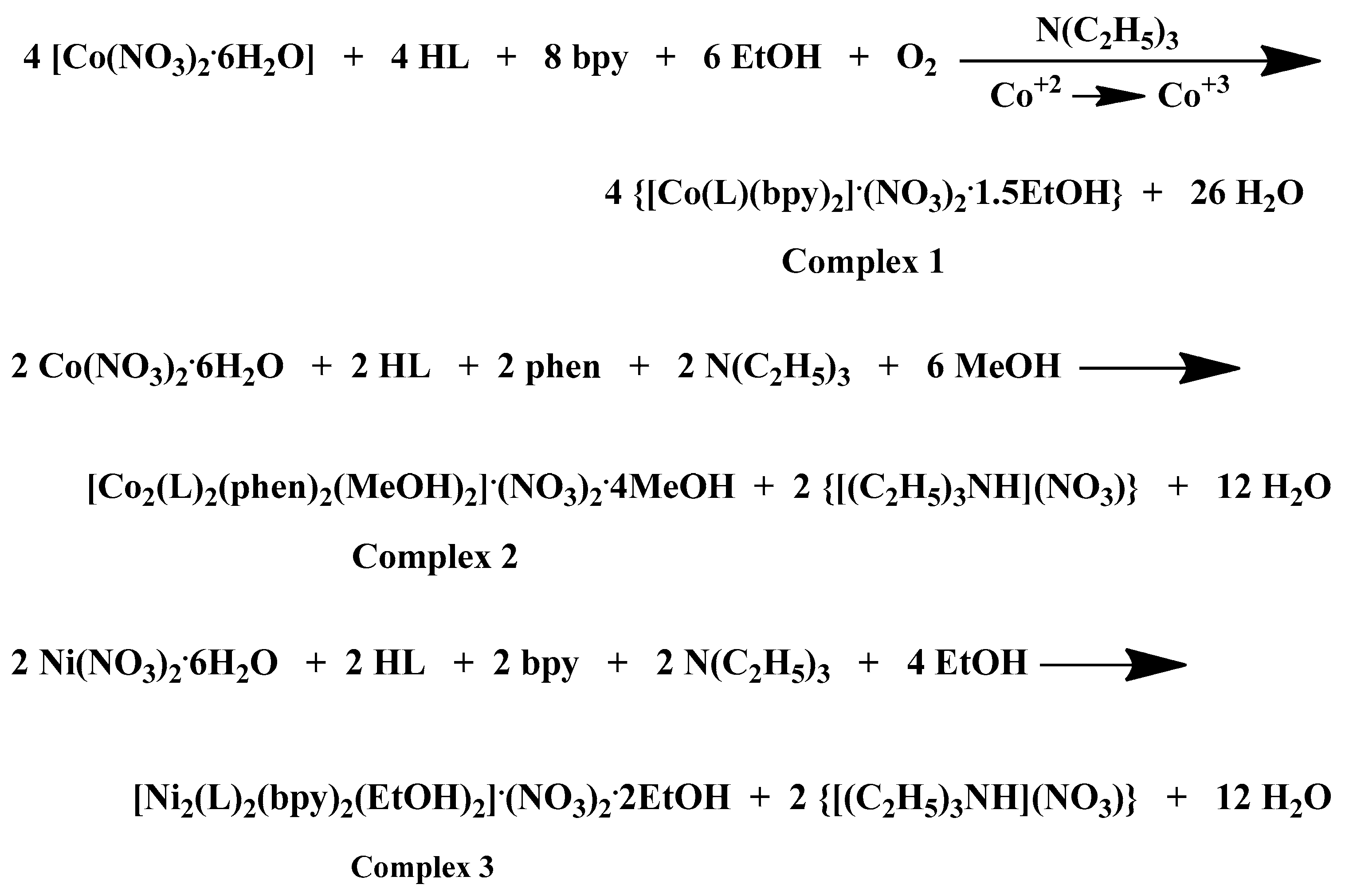

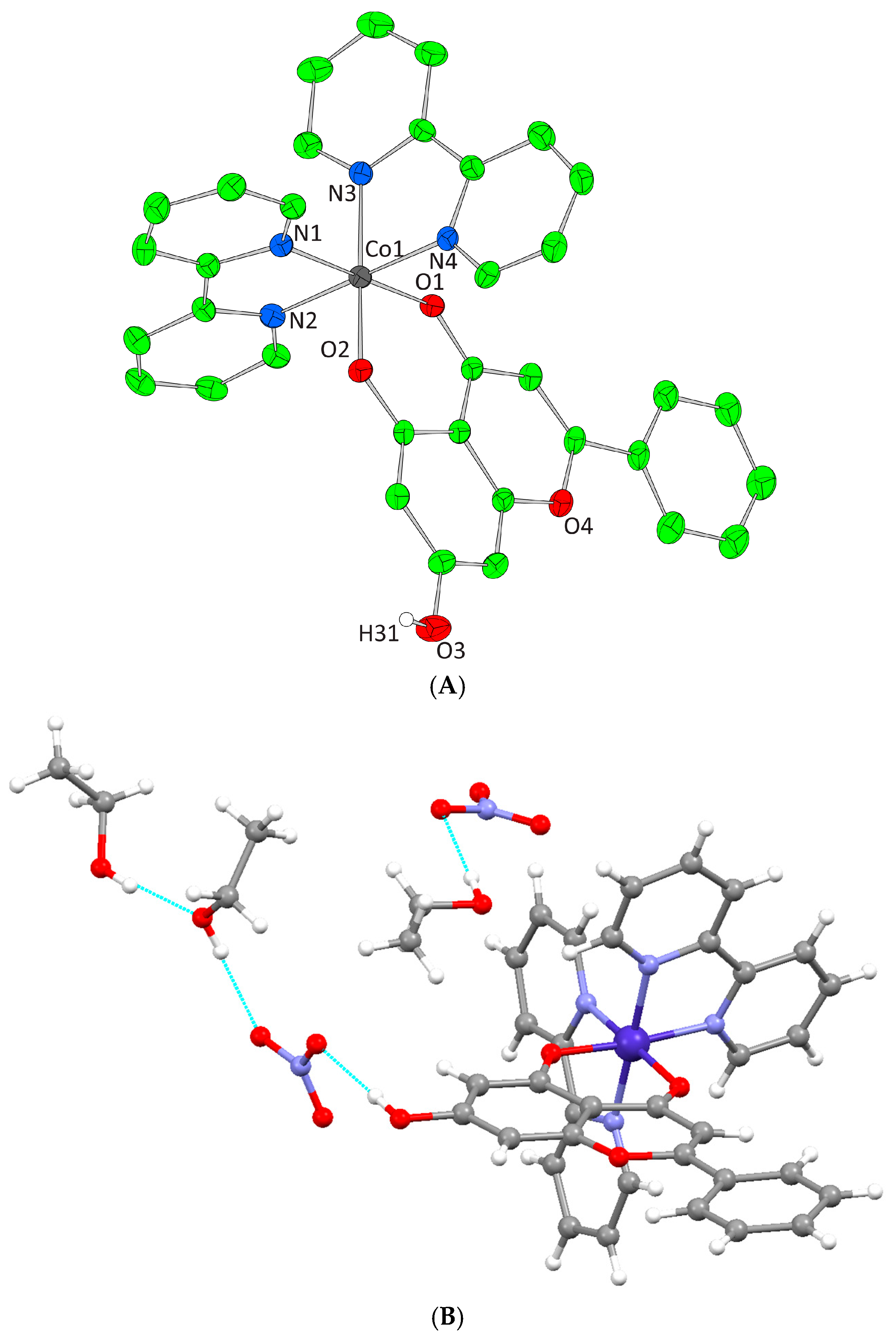
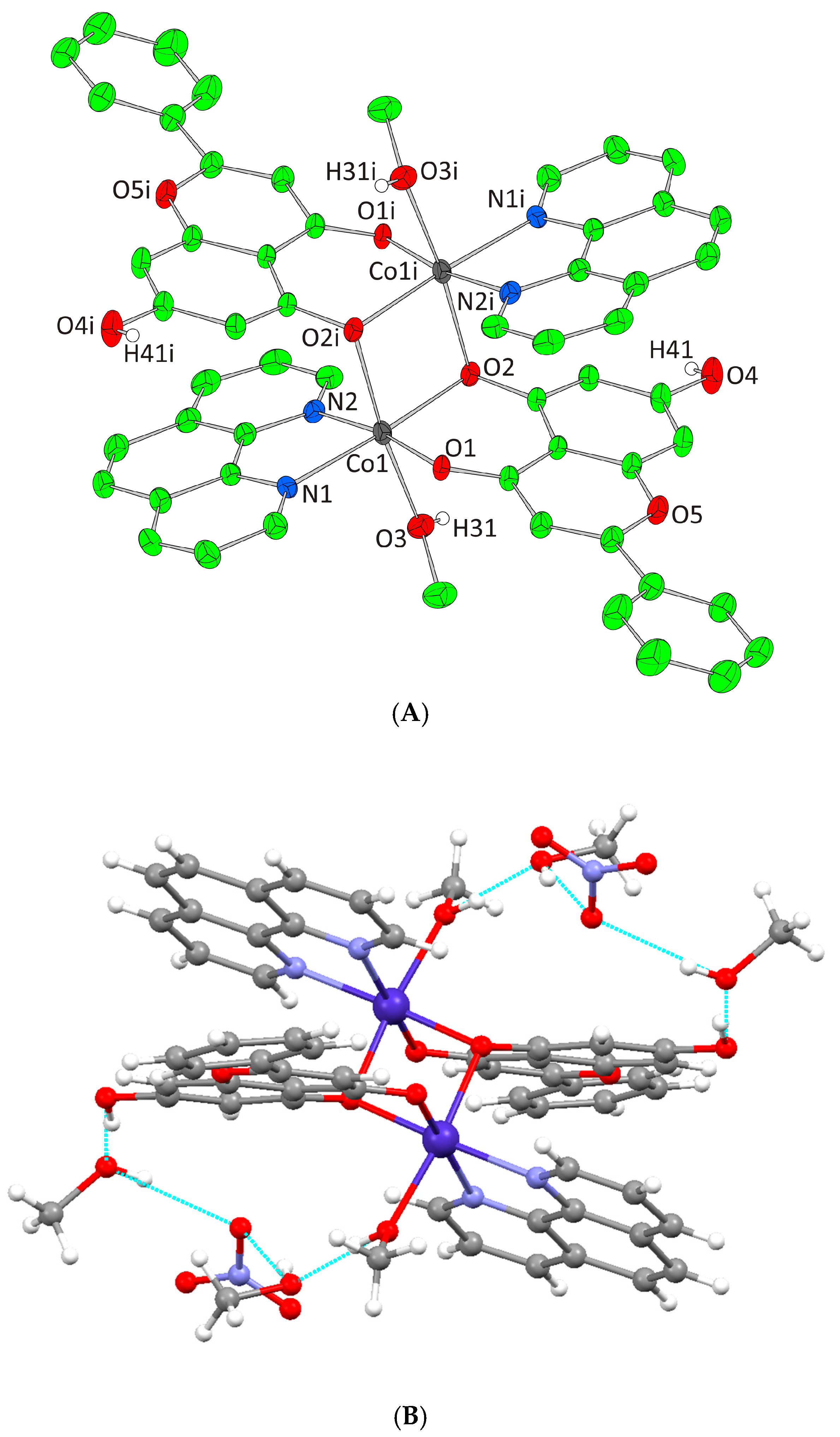
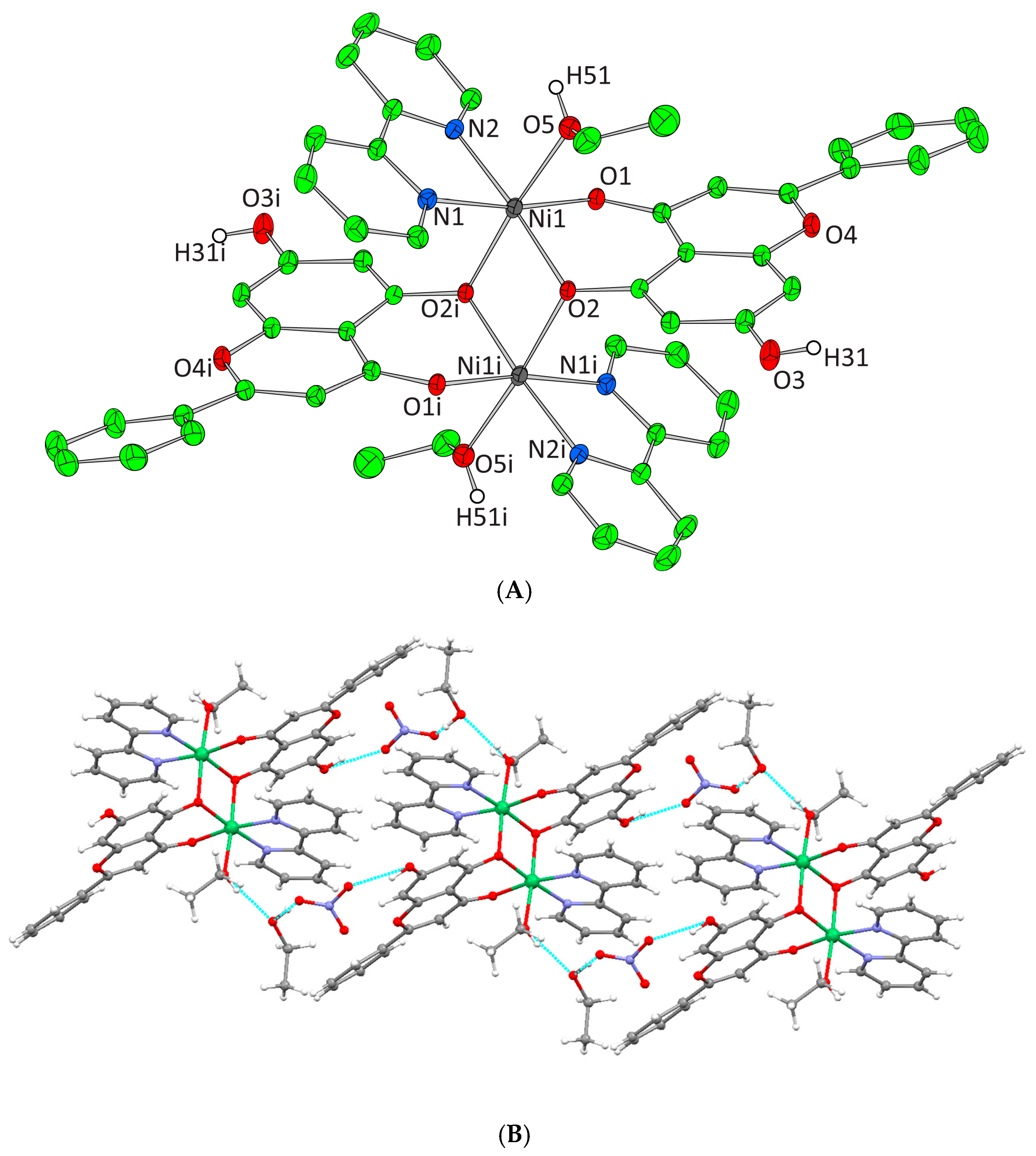
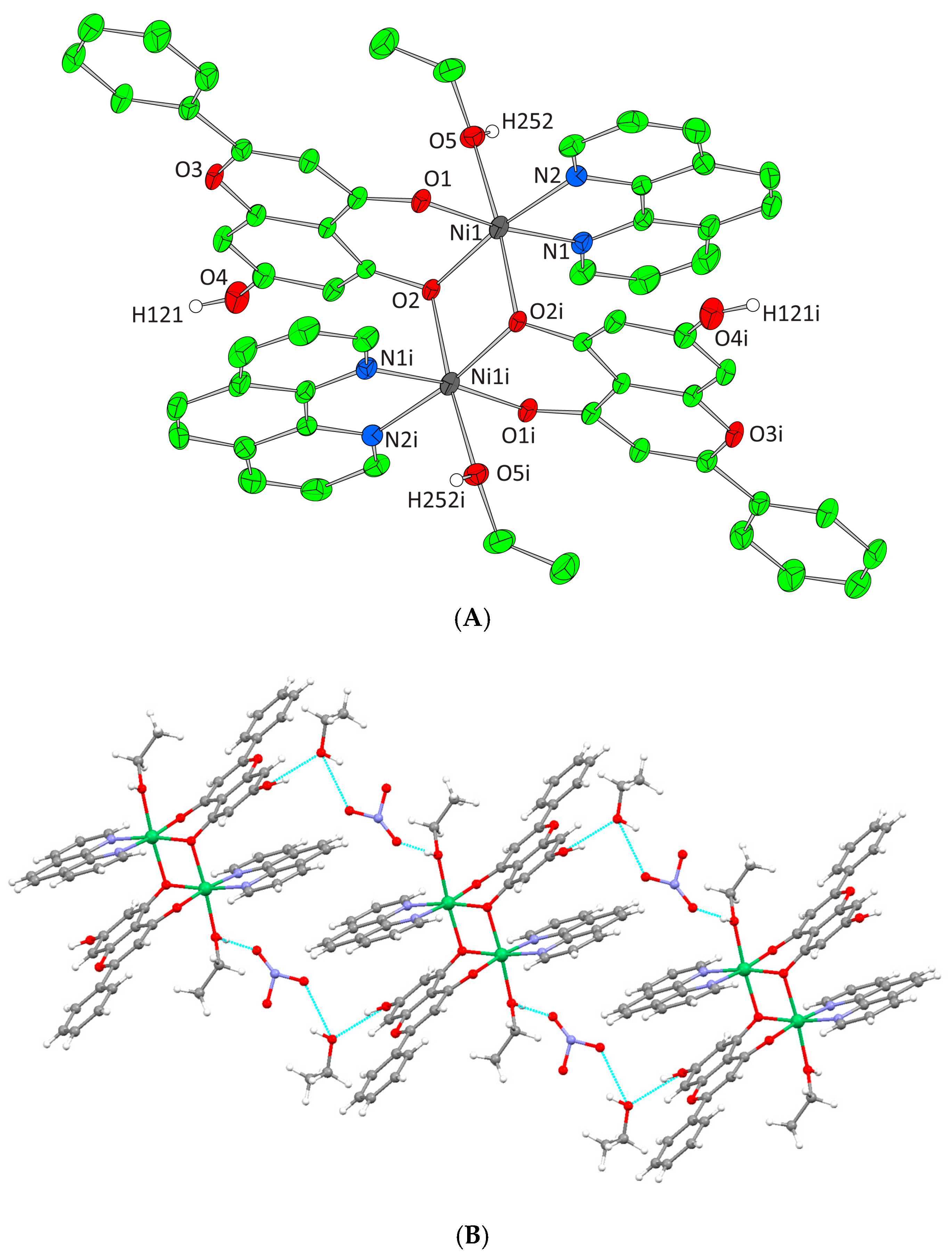

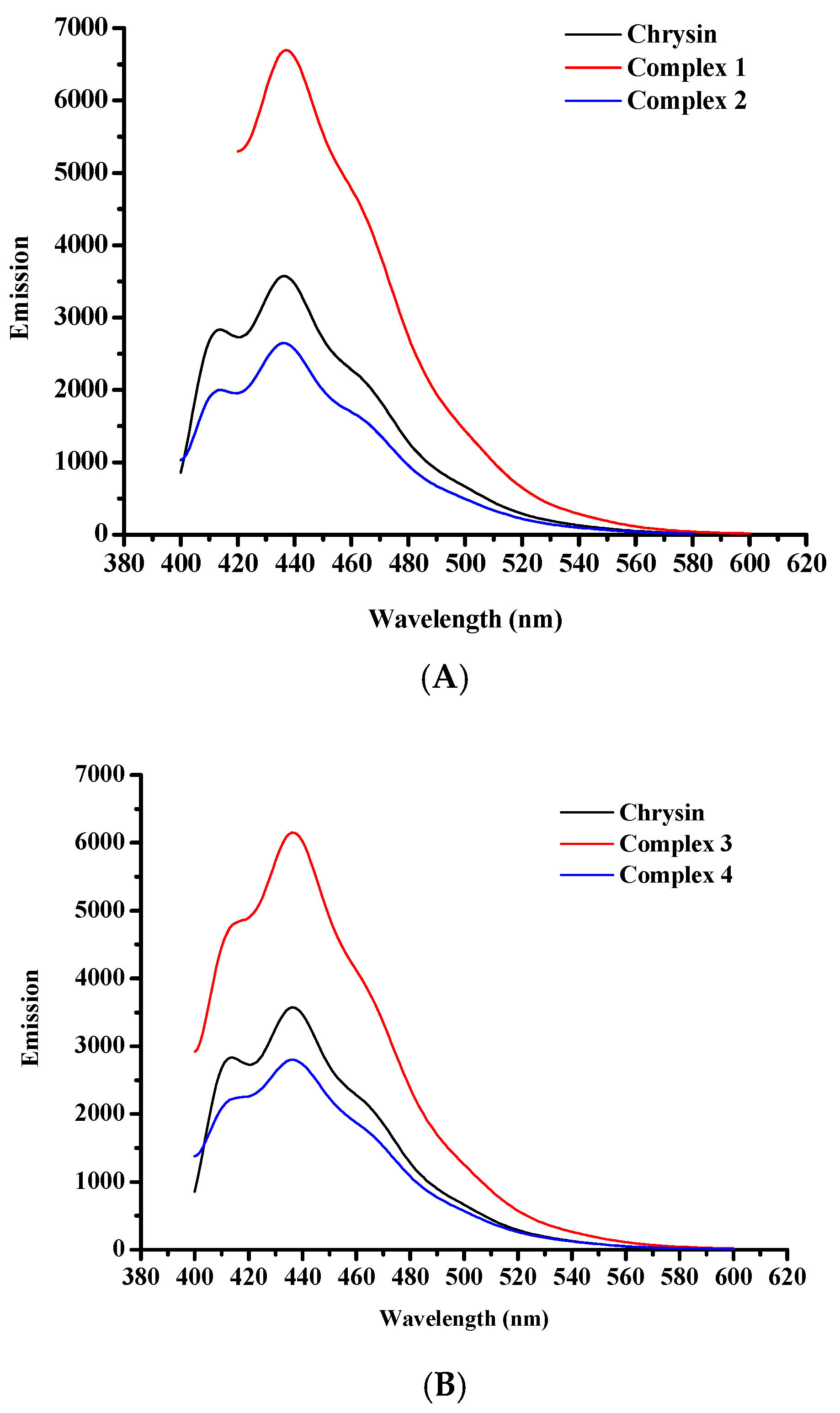

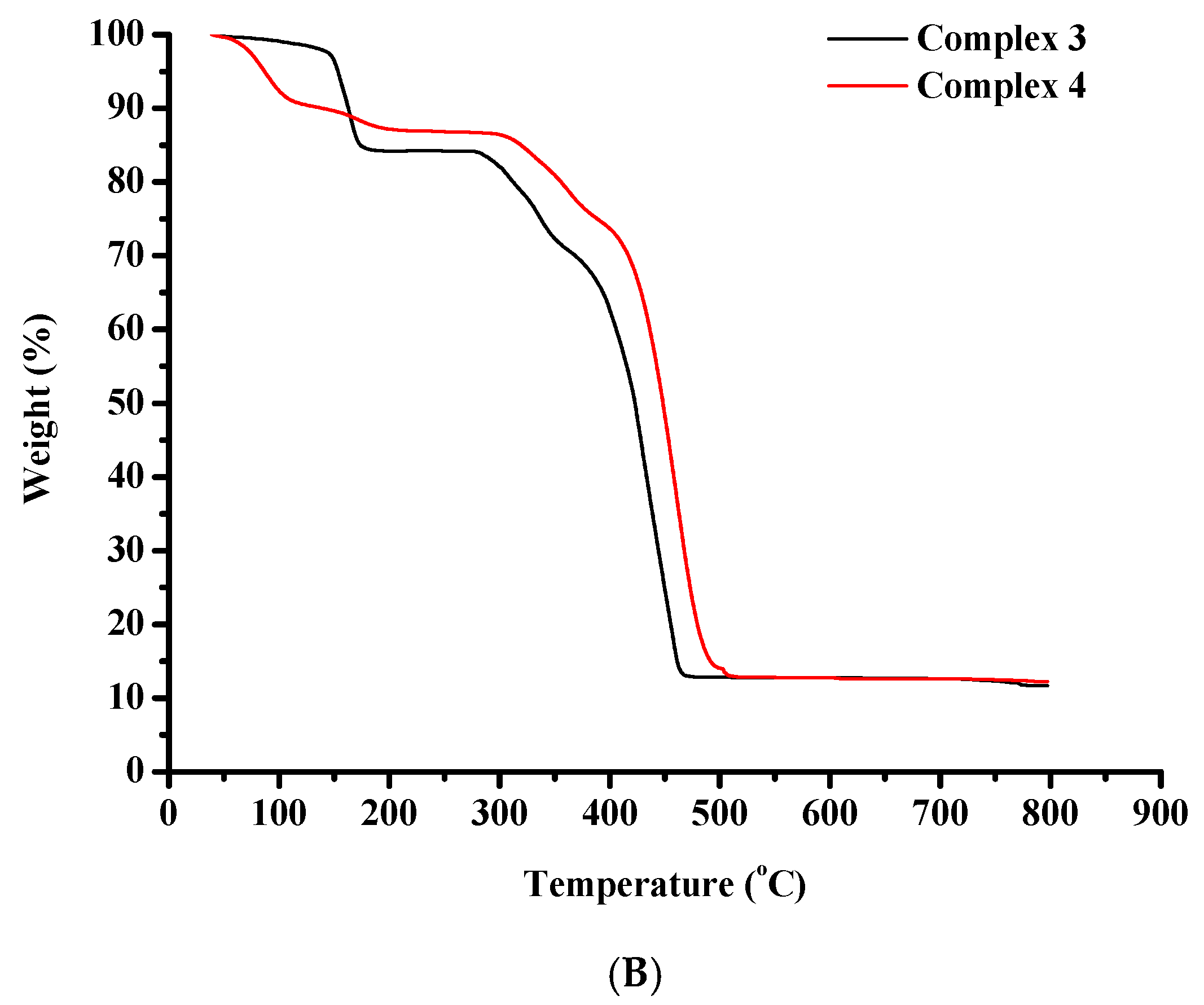

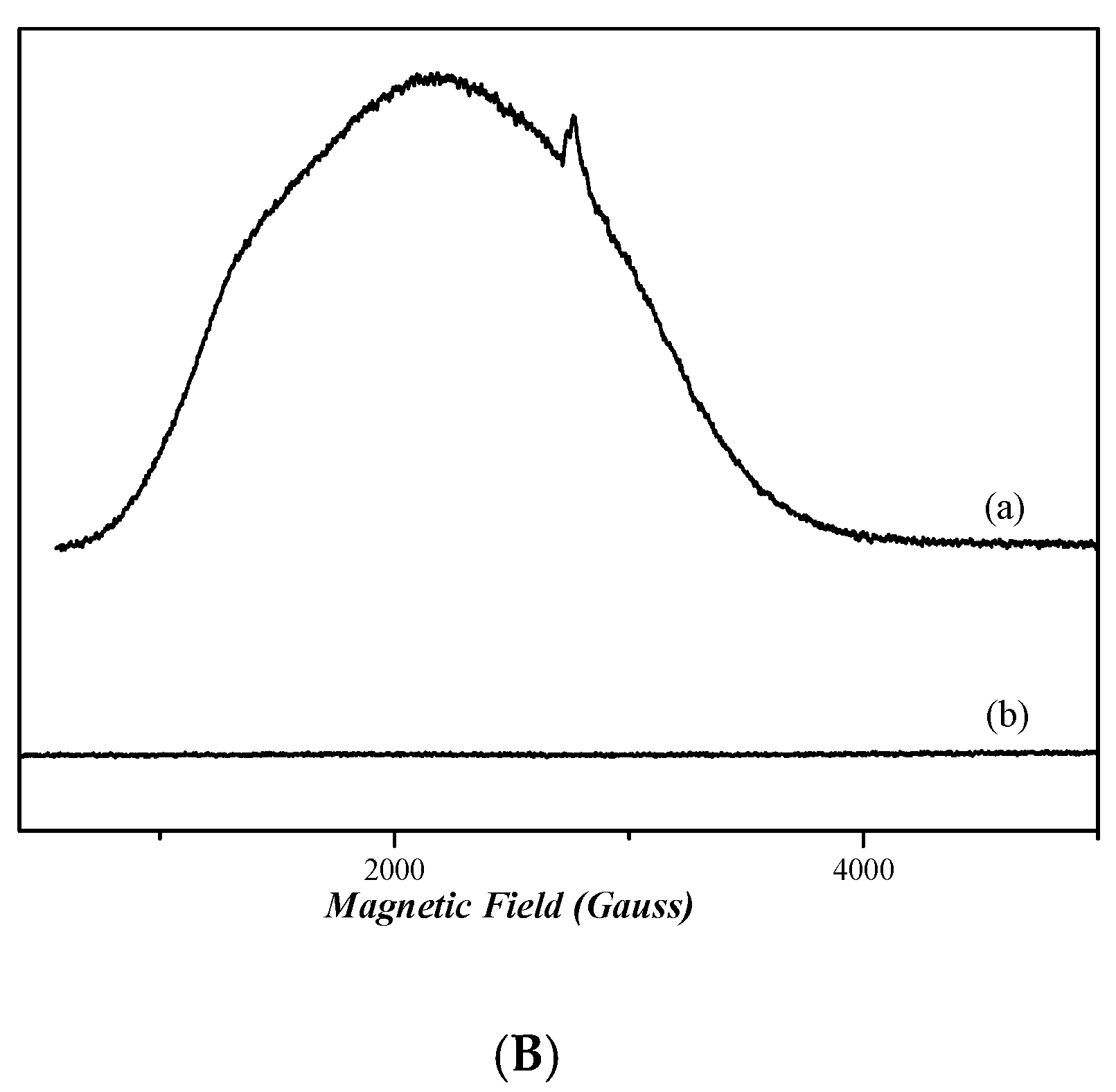
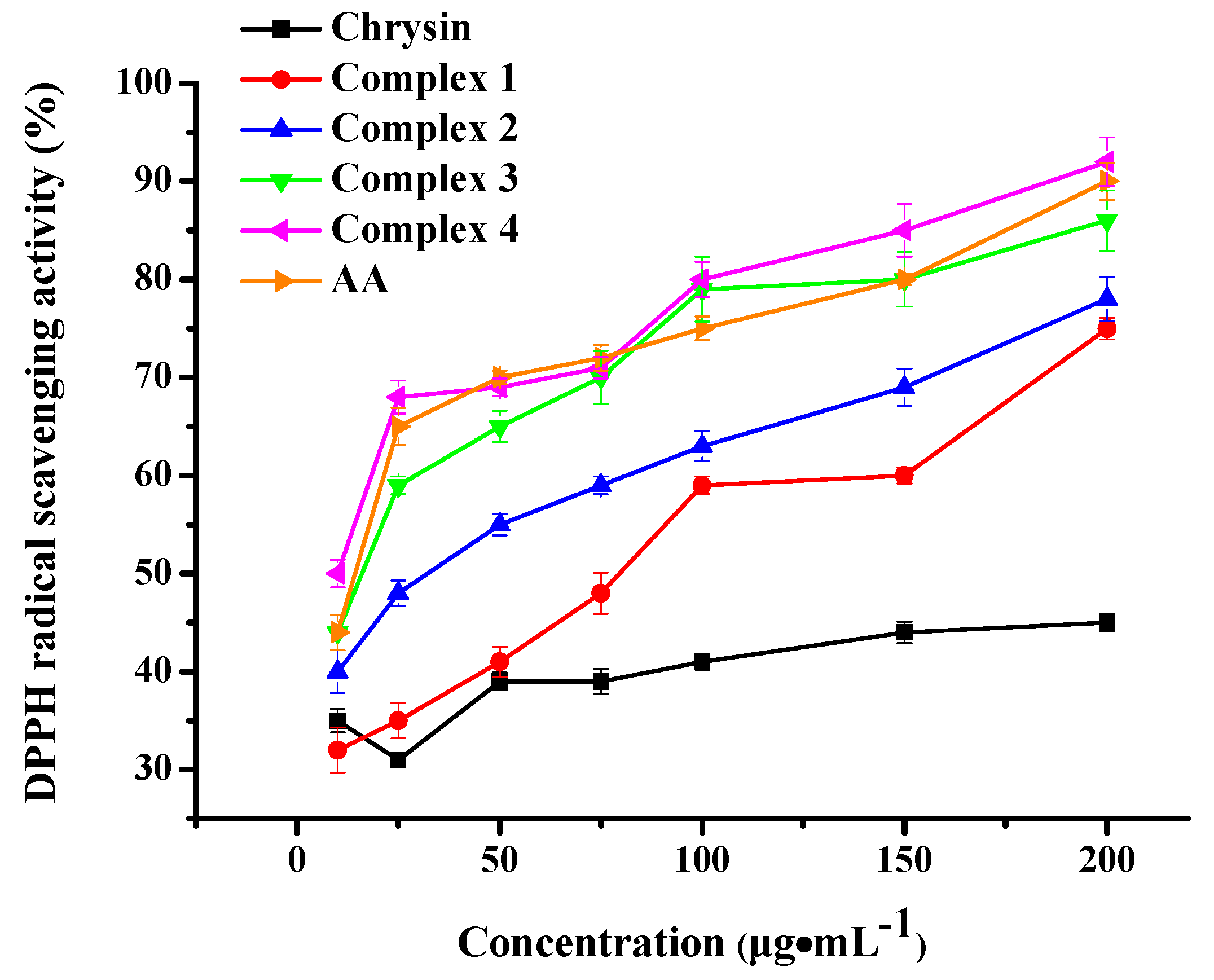
| Complex | λmax(em)/(nm) |
|---|---|
| 1 | 437, 649, 752 |
| 2 | 436, 649, 752 |
| 3 | 436, 708, 748 |
| 4 | 415, 436, 708, 748 |
Disclaimer/Publisher’s Note: The statements, opinions and data contained in all publications are solely those of the individual author(s) and contributor(s) and not of MDPI and/or the editor(s). MDPI and/or the editor(s) disclaim responsibility for any injury to people or property resulting from any ideas, methods, instructions or products referred to in the content. |
© 2025 by the authors. Licensee MDPI, Basel, Switzerland. This article is an open access article distributed under the terms and conditions of the Creative Commons Attribution (CC BY) license (https://creativecommons.org/licenses/by/4.0/).
Share and Cite
Halevas, E.; Mavroidi, B.; Varna, D.; Zahariou, G.; Litsardakis, G.; Pelecanou, M.; Hatzidimitriou, A.G. Structurally Characterized Cobalt and Nickel Complexes of Flavonoid Chrysin as Potential Radical Scavenging Compounds. Inorganics 2025, 13, 230. https://doi.org/10.3390/inorganics13070230
Halevas E, Mavroidi B, Varna D, Zahariou G, Litsardakis G, Pelecanou M, Hatzidimitriou AG. Structurally Characterized Cobalt and Nickel Complexes of Flavonoid Chrysin as Potential Radical Scavenging Compounds. Inorganics. 2025; 13(7):230. https://doi.org/10.3390/inorganics13070230
Chicago/Turabian StyleHalevas, Eleftherios, Barbara Mavroidi, Despoina Varna, Georgia Zahariou, George Litsardakis, Maria Pelecanou, and Antonios G. Hatzidimitriou. 2025. "Structurally Characterized Cobalt and Nickel Complexes of Flavonoid Chrysin as Potential Radical Scavenging Compounds" Inorganics 13, no. 7: 230. https://doi.org/10.3390/inorganics13070230
APA StyleHalevas, E., Mavroidi, B., Varna, D., Zahariou, G., Litsardakis, G., Pelecanou, M., & Hatzidimitriou, A. G. (2025). Structurally Characterized Cobalt and Nickel Complexes of Flavonoid Chrysin as Potential Radical Scavenging Compounds. Inorganics, 13(7), 230. https://doi.org/10.3390/inorganics13070230








